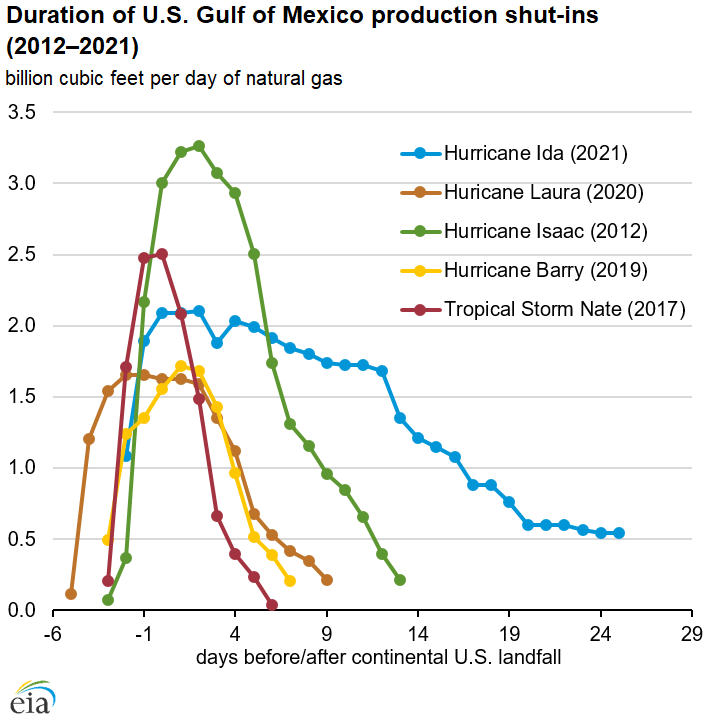Ida Reduced US NatGas Production More Than Any Hurricane in Past Decade
By U.S. Energy Information Administration
Hurricane Ida, which made landfall on Aug. 29, was the fifth-strongest recorded hurricane to make landfall in the continental United States. The hurricane caused more natural gas production shut-ins than any other hurricane in the past ten years, and the impacts continue today.
Hurricane Ida made landfall near Port Fourchon, Louisiana, as a Category 4 hurricane on the anniversary of 2005’s Hurricane Katrina. According to daily estimates from the U.S. Bureau of Safety and Environmental Enforcement (BSEE), Hurricane Ida reduced natural gas production in the Federal Offshore Gulf of Mexico by an estimated 38.4 billion cubic feet (Bcf) over 28 days, the most shut-in days reported by BSEE since 2012. At its peak of disruption, Ida shut in 2.1 billion cubic feet per day (Bcf/d) of Gulf of Mexico offshore production, of which approximately 0.2 Bcf/d remains impaired today, 60 days after Hurricane Ida made landfall.
At its peak, the disruption to offshore oil and natural gas activity caused by Hurricane Ida resulted in evacuating 288 production platforms and 11 drilling rigs. Fewer facilities were evacuated in advance of Hurricane Ida than for other recent hurricanes. For example, Hurricane Laura shut-in 299 platforms and 11 rigs, and Hurricane Isaac in 2012 shut-in 509 platforms and 50 rigs.
However, the duration of the shut-ins caused by Hurricane Ida, more so than the number of evacuations, contributed to the larger reduction in natural gas production. For the 28 days during which BSEE reported shut-in natural gas volumes as a result of Hurricane Ida, impaired natural gas production totaled 38.4 Bcf, or 56.0% of total U.S. offshore natural gas production in a month (when compared with the monthly total production for January of the same year) and 1.2% of total U.S. natural gas production (when compared with the monthly production total in January of the same year). By comparison, Hurricanes Laura (2020) and Isaac (2012) shut in 18.2% and 20.0% of offshore natural gas production, respectively, and 0.5% and 1.3% of total U.S. natural gas production, respectively, when compared with the production total in January of the respective years.
Hurricane Ida's direct hit to Port Fourchon had a significant effect on day-to-day operations of Gulf of Mexico offshore oil and natural gas production and the ability of operators to recover after the hurricane. Over 250 companies that service offshore oil and natural gas production in the Gulf of Mexico have a stake in Port Fourchon. As a result of damage sustained during the storm, 63 offshore platforms remained unmanned for 14 days after the hurricane made landfall, or 11.3% of all platforms in the U.S. Gulf of Mexico. BSEE reported that 5.5% of platforms were still unmanned 25 days after the hurricane made landfall. BSEE ceased reporting the impacts of Hurricane Ida on September 23, 28 days after the hurricane started to impact production, when Gulf of Mexico offshore natural gas production was still more than 0.5 Bcf/d below pre-hurricane levels. By comparison, Hurricane Isaac resulted in the second-most days of impaired production when it took 17 days for offshore production to return to pre-hurricane levels.
The impact of Hurricane Ida continues to affect U.S. Gulf Coast natural gas supply today. Production from Shell Offshore’s West Delta-143 platform remains offline and is not expected to return until the first quarter of 2022. Shell's West Delta 143 transportation hub, which aggregates production from Shell Offshore-operated Mars and Ursa platforms, sustained significant damage, shutting in approximately 220 million cubic feet per day (MMcf/d) of natural gas production.
The Atlantic hurricane season ends November 30, but most hurricane activity takes place in August, September, and October. Hurricane Ida is the only 2021 storm that resulted in BSEE activating its hurricane response team to monitor evacuation and production statistics. Named storms have winds with maximum speeds above 39 miles per hour. As of October 28, there have been 20 named storms during the 2021 hurricane season. Although 2021 has had more named storms than the 30-year average computed by the National Oceanic and Atmospheric Administration (NOAA), 2021 still lags behind 2020, which had 30 named storms during the Atlantic hurricane season, and broke the previous record set in 2005.
Related News
Related News

- Kinder Morgan Proposes 290-Mile Gas Pipeline Expansion Spanning Three States
- Valero Plans to Shut California Refinery, Takes $1.1 Billion Hit
- Three Killed, Two Injured in Accident at LNG Construction Site in Texas
- Tallgrass to Build New Permian-to-Rockies Pipeline, Targets 2028 Startup with 2.4 Bcf Capacity
- TC Energy Approves $900 Million Northwoods Pipeline Expansion for U.S. Midwest
- New Alternatives for Noise Reduction in Gas Pipelines
- EIG’s MidOcean Energy Acquires 20% Stake in Peru LNG, Including 254-Mile Pipeline
- Construction Begins on Ghana's $12 Billion Petroleum Hub, But Not Without Doubts
- DOE Considers Cutting Over $1.2 Billion in Carbon Capture Project Funding
- Valero Plans to Shut California Refinery, Takes $1.1 Billion Hit





Comments